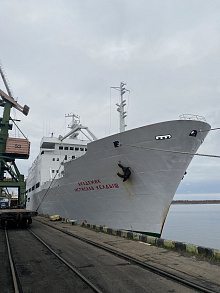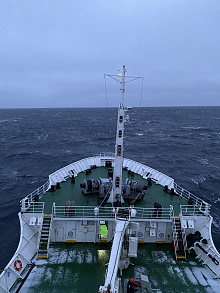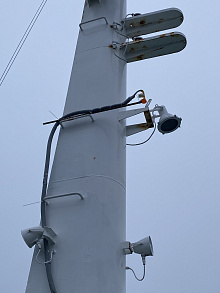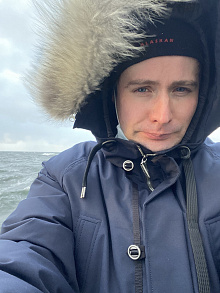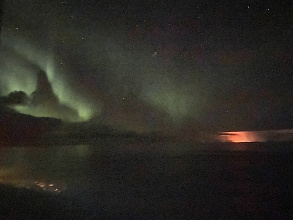Krasnoyarsk scientists explored the atmosphere of the Arctic in a marine expedition
14 February 2022 г.
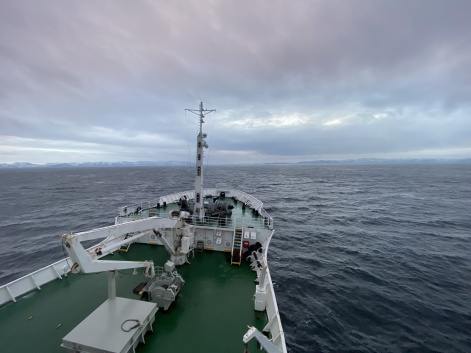
The Intergovernmental Panel on Climate Change classifies the Arctic as one of the most climate-sensitive regions in the world. The Arctic is in the early stages of change, influenced by the release of greenhouse gases associated with human activities. These gases change the radiation balance of the Earth and contribute to the accumulation of heat in the atmosphere. Among these gases, carbon dioxide and methane play a primary role in terms of their quantitative content in the atmosphere and the degree of influence on the Earth's radiation balance.
In the Russian Arctic, the central position is occupied by the Arctic territories of the Krasnoyarsk Regions, which account for a quarter of the area of the Arctic zone of the Russian Federation. These hard-to-reach areas remain a "blank spot" in predictive scenarios of climate and environmental change affecting many natural objects in the "atmosphere - vegetation - soil - hydrosphere" system. The gas composition of the atmosphere is particularly informative in this respect. It acts as an indicator reflecting the current state and changes in the environment.
Since 2018, with the joint efforts of scientists from the V.N. Sukachev Institute of Forest SB RAS, one of the institutes of the Federal Research Center "KSC SB RAS", and specialists from the Joint Directorate of Taimyr Reserves, the gas regime of the atmosphere in the Arctic is being monitored. Observations of carbon dioxide and methane concentrations are performed using a micrometeorological mast located on the coast of the Kara Sea near the village of Dikson, the northernmost settlement in Russia. In the Krasnoyarsk Region, this is the only atmospheric monitoring station beyond the Arctic Circle, and one of five stations located in the polar regions of the Russian Federation.
In 2021, observations in the coastal Arctic zone of the region were supplemented by measurements of the dynamics of the concentration of carbon dioxide and methane in the atmosphere of the Arctic Ocean, performed on the flagship of the research fleet of the Russian Federation "Akademik Mstislav Keldysh" during a comprehensive scientific expedition. This was the first sea voyage with the participation of scientists from the Institute of Forest SB RAS, invited by the head of the expedition, Corresponding Member of RAS Igor Petrovich Semiletov. Three specialists of the Institute took part in the expedition: Alexander Tsukanov, Leading Engineer of the Laboratory of Biogeochemical Cycles in Forest Ecosystems, Candidate of Biological Sciences, Svetlana Evgrafova, Senior Researcher at the International Laboratory of Ecophysiology of Permafrost Biogeocenoses, and Alexei Panov, Head of the Laboratory of Experimental and Applied Ecology, Candidate of Biological Sciences. In total, more than fifty people participated in the expedition: scientists and specialists from the Ilyichev Pacific Oceanological Institute FEB RAS, after P.P. Shirshov Institute of Oceanology RAS, Moscow State University, and Tomsk Polytechnic University.
The expedition started on October 2 and lasted a little over a month. The route started in Arkhangelsk, ran along the Barents Sea with access to the Northern Sea Route through the Kara Gate Strait. The expedition was supposed to pass through the Kara Sea, the Laptev Sea, and the East Siberian Sea. Unfortunately, the weather and ice conditions prevented the ambitious plans of scientists from being fully realized. The northernmost point of the expedition was 82 degrees - St. Anna Trench at the northern tip of Franz Josef Land.
Alexei Panov, head of the Krasnoyarsk team of scientists told how extreme was the first trip across the Arctic seas on such a famous ship, and what results were obtained by the scientists of the Institute of Forest in cooperation with oceanologists.
“After entering the Northern Sea Route, it became much colder, a strong heavy wind often blew with gusts of up to 20-25 meters per second. Autumn began. During the deck work, our hands quickly got frozen. Therefore, the main part of work was done inside. We went out only for sampling. In addition to severe weather conditions, the work was complicated by rolling: we had to fasten the analytical equipment in the laboratory with twine and clamps to the tables. It is hard to imagine how the chemists coped with the work in such conditions. But none of us particularly suffered from "seasickness". Before the trip, we were worried about how we would survive being there for the first time, moreover, in the northern seas. But everything was fine.
The day began at 7 am with the announcement of the chief mate and good morning wishes to everyone on the ship's radio. He always noted what holiday it was today: someone's birthday or another important date. There was something every day. Then there was breakfast at 7.30, and scientific and technical meeting at 9.00, where the supervisors of the teams and scientific directions discussed the plans for the day and the results already achieved. Then, we worked in the laboratories. This is a wide range of research - not only the atmosphere, because a number of research teams were brought together as to hydrology, hydrochemistry, hydrobiology, hydroacoustics and many other areas. Each team had its own laboratory. When the ship stopped, all sorts of sensors and scientific equipment were immersed in the water. Scientists took samples of water, bottom sediments, microplastics, etc. We monitored the operation of gas analysis equipment and processed the data obtained.
Almost every day at 17.00 scientific seminars were held, where scientists from different teams and directions reported on their work, with further discussion. People exchanged knowledge and the results obtained. In the evening, we had dinner and again worked in the laboratory.
There were, of course, informal evenings. Plus, new vivid impressions: we repeatedly saw the stunningly beautiful northern lights, ice, even polar bears on the ice. Yes, a lot of things that we have not seen before this trip. And of course, the sea. In all its states. But the main thing is that there was a lot of interesting scientific work, so the month flew by in one breath. Many scientists dream of getting on this ship for their research. We were lucky. A serious level, everything is provided, up to places for physical activity - a gym and a sauna.
We worked together with scientists from Vladivostok, Moscow, and Tomsk. Almost everyone met for the first time. For us, cooperation with oceanologists turned out to be highly valuable, because the Institute of Forest does not have enough competence to assess the processes occurring in the depths of the ocean and causing changes in the composition and dynamics of greenhouse gases in the atmosphere. We have a good relationship with our new colleagues. We hope that now we will continue our joint work. The assessment of the role of the oceanic atmosphere in the results that we got in the coastal zone will be more multifaceted.”
The Institute of Forest SB RAS has been engaged in atmospheric research since 2005, that is, for more than 15 years. As a result of many years of research in the Yenisei River basin, a unique network of atmospheric monitoring stations has been created. It is based on the international observatory “ZOTTO”, a polar station in the village of Dikson and several micrometeorological masts for estimating carbon exchange flows by the method of turbulent pulsations located in key ecosystems of the Krasnoyarsk Region. For many years, the network has been supported and developed by grants from the Russian Science Foundation, RFBR, RSF. With the creation in Krasnoyarsk of the world-class Scientific and Educational Center "Yenisei Siberia", scientists hope for further large-scale research and receiving targeted funding.
In 2021, as the first stage of the project implementation of the REC "Yenisei Siberia", a youth laboratory of experimental and applied ecology was established at the V.N. Sukachev Institute of Forest under the leadership of Alexey Panov. The tasks of the laboratory include the development of a network for measuring the exchange flows of greenhouse gases and the assessment of changes in carbon stocks, the creation of GIS and the development of strategies for remote monitoring of climatically active gases, as well as the development and field testing of technologies aimed at reducing emissions and increasing carbon absorption.
Climate change and greenhouse gas emissions affect not only ecology, but also the economy, pricing, food supply and relationship between countries. At the same time, studies of greenhouse gas emissions are conducted on a small amount of actual material and, as a result, do not reflect the regional specific of carbon stocks and flows. In this regard, there is an urgent need to develop modern and objective instrumental methods for timely monitoring and calculation of absorption capacity at the regional and federal levels. This is the aim of the new laboratory.
The increasing complexity of ongoing studies of greenhouse gases and the consideration of the components of all media in the system “atmosphere - terrestrial ecosystems – ocean”, bring the research to a new level of studying the dynamics of the atmosphere and predictive assessments of its relationship with changes in climate and environmental parameters.
____________________________________________
The research program is being implemented within the framework of the REC “Yenisei Siberia”, with the financial support of the Russian Foundation for Basic Research, the Government of the Krasnoyarsk Region and the Krasnoyarsk Regional Science Fund within the framework of scientific projects No. 20-45-242908 and No. 20-44-242004 and that of the grants provided by the Russian Science Foundation No. 21-17-00163 and No. 21-77-30001.
In preparing the material, use was made of the text of the article “Studying the breath of the Arctic: on the way to the formation of a carbon polygon in the polar region of the Yenisei Siberia”. Authors: A.V. Panov, A.S. Prokushkin, E.A. Kukavskaya, M.A. Korets, A.V. Urban, A.A. Tsukanov, I.N. Kornienko, M.G. Bondar’
Share:

